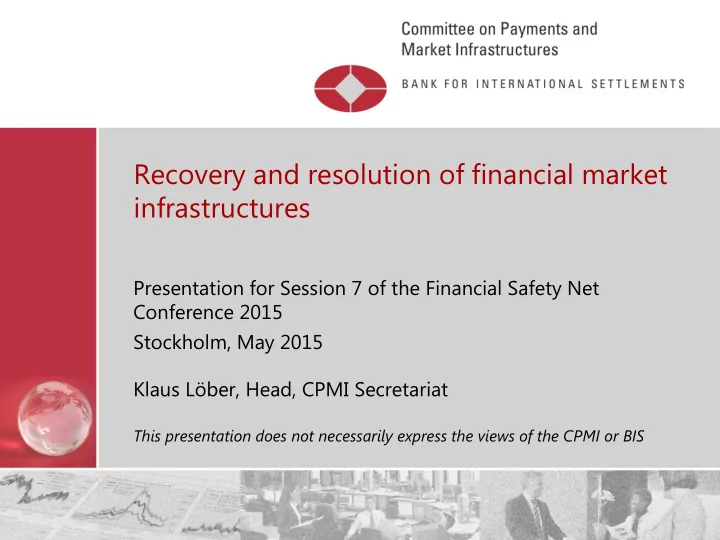

Recovery and resolution of financial market infrastructures Presentation for Session 7 of the Financial Safety Net Conference 2015 Stockholm, May 2015 Klaus Löber, Head, CPMI Secretariat This presentation does not necessarily express the views of the CPMI or BIS
FMI risk management, recovery and resolution Responsibility of the FMI, overseen by the central bank etc Risk management is the “everyday” management Risk management of risk by the FMI, including dealing with Covered by the CPMI-IOSCO PFMI anticipated problems (2012) Recovery for an FMI is the extreme end of risk Recovery management – dealing with the most extreme Covered in more detail by the CPMI- financial threats that could threaten its survival IOSCO report on FMI recovery (2014) Responsibility of the resolution authority Resolution is an alternative regime to insolvency to Resolution enable authorities to restore, restructure or wind- Covered by the FSB’s “Key attributes of down an FMI without severe systemic disruption effective resolution regimes”, including an FMI-specific annex (2014) and without exposing taxpayers to loss. 2
Banks and FMIs are different Development of the concepts of recovery and resolution driven by bank failures – the desire to avoid “too big to fail”. But FMIs are very different: FMIs are a critical service Often there is no alternative So closing an FMI is usually not a realistic option FMIs’ balance sheets are typically very different from banks’ (usually not designed to bear substantial risk themselves) They are required to have comprehensive risk management (ie the PFMI) They regularly already have arrangements to share losses (with their participants, as part of the FMI’s rules) So the sorts of tools for bank recovery and resolution aren’t necessarily useful for FMIs 3
Emphasis on recovery The importance of FMIs, and the lack of alternatives, means the emphasis has to be on recovery Nevertheless, there is no guarantee that FMI recovery plans will work. If they fail, resolution will be needed. Triggers for resolution: recovery plan has failed (but that may be too late) recovery plan was not implemented in a timely way authorities decide that plan will fail or compromise financial stability Even then, the key difference is that it is the authorities trying to recover the FMI rather than the FMI itself trying to do it 4
Tools for recovery and resolution Recovery and resolution are about the ability of an FMI to cope with even the most extreme financial problems Participant Investment Business Operational Legal risk default and custody risk risk risk Financial consequences Funds or Taxpayer Third party FMI’s capital collateral funds funds from (eg insurance) participants Who bears the loss is a largely a matter of fairness and effectiveness 5 5
Focus on CCPs and participant default Problem can be an outright loss. Or it can be a liquidity shortage Initially, the FMI will typically use existing (pre-funded) financial resources to cover a loss. And pre-arranged liquidity facilities to turn those resources into cash if necessary. This is “normal” risk management But if the problem is too big, those resources and/or facilities may not be enough. This is when the FMI needs a recovery plan, about how it is going to cope in these circumstances Risks vary in size and how much they can be predicted and/or controlled. They thus vary in how likely it is that the resources/facilities run out and the recovery plan needs to be activated. But there’s always some likelihood 6
Criteria for judging recovery tools Comprehensive Effective Transparent and manageable/controllable Create appropriate incentives Minimise negative impact Need a set of tools But still likely to involve trade-offs In practice the range of adequate tools is quite limited 7
Recovery tools: example for a CCP There are a range of tools a CCP could use if a default were to be so extreme that the waterfall didn’t cover it. For recovery: To deal with uncovered losses • Tools such as cash calls (participants provide additional resources to the CCP) or variation margin “haircutting” (reducing the CCP’s liabilities to participants) To deal with uncovered liquidity shortfalls • Similar tools may also be used to cover liquidity shortfalls The CCP will also need to: Re-establish the CCP’s matched book • If voluntary methods (eg auctions, CCP purchases of offsetting positions, incentives to participants to accept unmatched contracts) don’t work, involuntary tools may be needed (eg forced allocation of contracts or contract tear-up) Replenish financial resources and capital • Cash calls can also be used to replenish participants’ contributions. Ex-ante arrangements with existing owners, voluntary arrangements with participants, or bail-in of debt (where applicable) can be used to recapitalise. Similar tools are likely to be key in resolution too
Outstanding issues FMI recovery (CPMI-IOSCO) Assess the current position of CCP recovery planning, possibly as part of its implementation monitoring work Possibility of more granular standards for CCP recovery FMI resolution (FSB) Stocktake of existing CCP resolution regimes and resolution planning Minimum standards for resolution planning (building on Key Attributes ) Assess the need for additional capital and liquidity resources in resolution 9
Recommend
More recommend